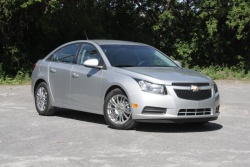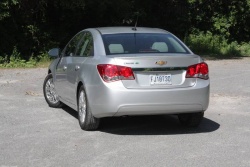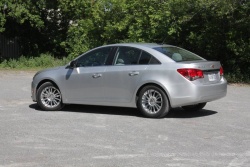 2011 Chevrolet Cruze Eco. Click image to enlarge |
|
Related links
Manufacturer’s web site |
Review and photos by Chris Chase
Photo Gallery:
2011 Chevrolet Cruze
Hybrids are good at saving fuel, but they cost thousands more than comparable gasoline-powered cars, and it can take years of driving to make back that difference in purchase price. There are a number of gas-only cars on the market now, however, that approach hybrid efficiency at a more palatable price.
Chevrolet is the latest vehicle to venture into the fuel-saving fray with its gas-only miser Cruze Eco model. The Cruze is Chevy’s mainstream compact sedan, playing in the same sandbox as notables like the Honda Civic and Hyundai Elantra, two cars I single out for reasons that will be explained shortly.
To all appearances, this car is as much a mainstreamer as any Cruze trim, save for unique wheels (if you have an eye for such things), a lower front bumper and different grille (more on that shortly) and subtle badging.
  2011 Chevrolet Cruze Eco. Click image to enlarge |
The lower front bumper valance is part of a suite of design elements – most of which are invisible to the casual observer – that also includes extra underbody panels, rear spoiler, lowered suspension and shutters behind the lower front grille that all work together to improve the Cruze’s aerodynamics. Mechanically, the Eco gets longer transmission gearing (which is to say, the engine turns at a lower rpm at a given road speed than a non-Eco Cruze), plus low rolling-resistance tires mounted on lightweight 17-inch alloy wheels.
At 1,365 kg (3,009 lbs), the Eco is also about 100 kg (220 lbs) lighter than the comparable LT Turbo model. That’s the result of changes to the car’s body, the lighter wheels (each one is 2.4 kg lighter apiece than the 16-inchers on the LT Turbo) and the omission of a spare tire (which is replaced by a pump and a can of tire sealant). Even with those measures in place, the Cruze is still heavier than stickshift versions of the Civic EX and Elantra, respectively.
Those thrift-minded changes are matched exclusively with the 1.4-litre turbocharged four-cylinder that is positioned as the premium choice, next to the Cruze’s base 1.8-litre engine. Power numbers are 138 horsepower and 148 lb.-ft. of torque for my tester’s turbo mill, where the 1.8-litre’s ratings are 136 hp/123 lb.-ft. A six-speed manual is standard in the Eco (in fact, the Eco is the only Cruze that pairs the turbo engine with a stickshift), and the same six-speed automatic offered elsewhere in the Cruze line-up is optional.
Taken all together, the aero add-ons and mechanical changes help drop the Cruze’s fuel consumption ratings to 7.2/4.6 L/100 km (city/highway) with the manual transmission, and 7.8/5.1 with the automatic. For comparison, the 1.8-litre Cruze LS is rated at 8.5/5.5 with the stickshift, while the LT Turbo model and its standard-kit auto-box is pegged at 9.2/5.6 L/100 km. Notable competitors in the economy wars are the 2012 Honda Civic, rated at 7.2/5.0 L/100 km with an automatic transmission, and the 2011 Hyundai Elantra, which does even better, at 6.9/4.9 with the automatic.
But, of course, real-world numbers are where it’s at in a car whose maker claims improved efficiency. Here, the Cruze Eco seems to live up to its hype: my tester averaged 7.4 L/100 km in city driving and, according to the trip computer’s fuel consumption readout, seemed easily capable of highway averages in the low 5.0 L/100 km range, with a light right foot. In keeping up with the flow of traffic on Ottawa’s Highway 417, I averaged a little less than 6.0 L/100 km.
  2011 Chevrolet Cruze Eco. Click image to enlarge |
The Eco’s performance presents a sharp contrast to the Cruze LT+ Turbo I tested back in January 2011. That car (1.4-litre/automatic) averaged 9.6 L/100 km in similar driving, but facing the obvious detriment of winter temperatures, so it’s not exactly a fair comparison. Other small cars I drove last year, in various weather and traffic conditions, included a Toyota Yaris (automatic, 8.4 L/100 km), a Mazda2 (automatic, 8.1 L/100 km), a Scion xD (automatic, 9.0 L/100 km) and a Ford Fiesta (manual transmission, 7.6 L/100 km).
The Cruze Eco is blessed with the same on-road refinement as other Cruze models, so it’s very quiet over smooth roads. The loudest thing you’ll hear is the way the wheels “whump!” over potholes, but it’s a high-quality sound that’s a far cry from the cheap clunk-and-thunk soundtrack that’s the norm in many compacts and even some mid-size cars. The suspension is well-tuned, for a ride that’s nearly perfect. The steering is overboosted, but responsive, and handling is good. In spite of the Eco’s lower curb weight, it still feels heavy when tossed around corners, but this works in its favour to give it a planted feel at highway speeds. Roadholding is let down by the low-resistance tires, which don’t offer much grip in hard cornering.
The current lack of interest in the stickshift seems to have led many manufacturers to invest little effort in making manual transmissions that are pleasant to use, especially in economy cars. Therefore, it’s a surprise that the Cruze’s is as nicely-tuned as it is. The shifter is precise, and clutch take-up progressive. As good as the shifter is, however, it doesn’t make the Cruze Eco fun to drive. Even with the engine’s torque peaking at a low 1,850 rpm, the tall gearing makes the car feel lazy unless you positively flog it, and even then, acceleration is a relaxed affair. If you want to add speed in a hurry on the highway, fifth and sixth are useless, and in fact you won’t get any serious pull above third. On the plus side, the engine is a smooth, happy revver and sounds very refined. It’s clear the Cruze Eco isn’t geared toward the enthusiast driver, which lines it up quite nicely with hybrids, the archetypal miser-mobiles that fun forgot.
   2011 Chevrolet Cruze Eco. Click image to enlarge |
The Eco isn’t Chevy’s first attempt at building a hyper-efficient compact. That was the Cobalt XFE, a car I had the distinct “pleasure” of testing in 2008. That car boasted nothing more than longer gearing and low-resistance tires and averaged an underwhelming 9.5 L/100 km in city slogging (albeit, again, in fuel-slurping cooler weather). Needless to say, the Cruze Eco is not only a more comprehensive attempt at saving fuel, but it’s also a far more pleasant car to drive. In fact, the Cruze is one of the most refined small cars on the market now, even if this Eco model is thoroughly unexciting in a straight line.
Inside, the Cruze Eco is par for the class, with mostly hard plastics tempered with vinyl panels on the dash and doors that are pleasant to look at and touch; these bits dress up an otherwise ordinary dash. The seats are polarizing – I liked the driver’s seat, but more than one passenger hated the right-front chair. What stands out is that both front seats get four-way height adjustability – not just the driver’s – which is rare. The rear quarters are strictly average, space wise, and the bottom cushion is hard as a rock. The lack of a spare tire in the Cruze leaves a shallow well in the trunk floor that adds 11 litres (0.4 cu.ft.) of cargo space for a total of 436 litres; at the very least, it’s handy for keeping loose items from rolling around. The seats fold – nothing close to flat, but enough to let me schlep 14 four-foot-long boxes of laminate flooring home.
The Cruze Eco comes with an MSRP of $19,495 (the same as the LT), and a reach from the base LS’ $14,995. To that stripper (which, to be fair, includes niceties like power locks with keyless entry, automatic headlights and variable intermittent wipers) the Eco adds the turbocharged engine, 17-inch alloy wheels, air conditioning, heated power mirrors, rear spoiler, cruise control, floor mats, auto-dimming rear-view mirror, driver’s auto up/down window, and XM satellite radio, plus all of the economy adders listed off the top of this review. My tester came with one extra – the $745 Connectivity Package, which adds Bluetooth, a USB stereo input (both of which should be standard) and OnStar, and a $65 tire pressure monitoring system. Those options took the as-tested tag to $20,405. At the time of this writing, the Cruze Eco was eligible for a $1,700 discount from General Motors.
The similarly-equipped Elantra GL starts at $17,999, and the slightly less well-equipped Civic LX is worth $17,490.
The Cruze took the Automobile Journalists Association of Canada’s Canadian Car of the Year for 2011, and for good reason: it’s a small car that impresses by driving like a bigger, more expensive one. What’s less clear is the reason for Chevrolet’s decision to limit its fuel-saving efforts to one special model; the Cruze would be even more attractive to consumption-conscious shoppers if the entire line benefited from the Eco’s economy-boosting features.
|
Pricing: 2011 Chevrolet Cruze Eco
Specifications
Competitors
Crash test results
|











